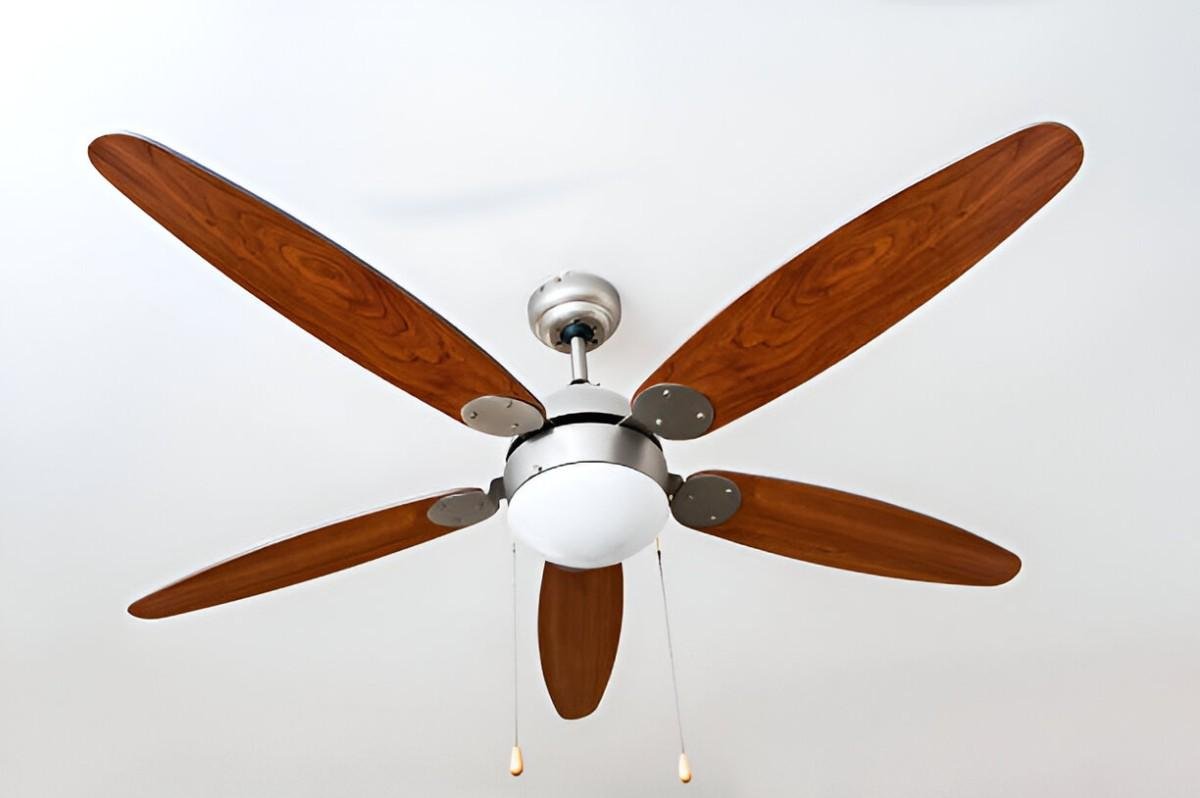Ceiling fans are more than just a functional addition to any room; they can improve air circulation, enhance comfort, and even contribute to energy efficiency. But buying the best ceiling fan isn’t as straightforward as it might seem. With so many types, sizes, and features to consider, choosing the right one can feel like a daunting task. In this guide, I’ll walk you through everything you need to know to make an informed decision when purchasing a ceiling fan. Whether you’re replacing an old fan or outfitting a new space, this article will help you pick the best ceiling fan for your needs.
Table of Contents
1. Understanding the Basics of Ceiling Fans
Before diving into the specifics, it’s important to understand what a ceiling fan is and how it works. A ceiling fan consists of blades that rotate around a motor, generating airflow. The primary function of a ceiling fan is to circulate air, which helps cool down a room by increasing the evaporation of sweat on your skin. Fans can also reverse direction in colder months to push warm air down.
Types of Ceiling Fans
There are several types of ceiling fans, and choosing the right one depends on the space, aesthetic, and functional needs. Let’s take a look at the most common types:
- Standard Ceiling Fans: These are the most common and are designed for general use. They come in various sizes, styles, and finishes.
- Energy-Efficient Ceiling Fans: Designed with efficiency in mind, these fans are often equipped with DC motors or other features that reduce energy consumption.
- Outdoor Ceiling Fans: Built for use in outdoor spaces, these fans are resistant to moisture and humidity.
- Low-Profile Ceiling Fans: These are ideal for rooms with low ceilings. The fan blades are typically closer to the ceiling, making them a good choice for smaller spaces.
- Smart Ceiling Fans: These fans can be controlled via apps or voice commands and offer additional convenience with features like adjustable speeds, lights, and scheduling.
2. Key Factors to Consider When Choosing a Ceiling Fan
When it comes to selecting the right ceiling fan, several factors play a role in your decision. Let’s go through them one by one:
a. Room Size
The size of the room plays a significant role in choosing the right fan. A fan that’s too small won’t circulate air efficiently, while one that’s too large may cause excessive airflow and discomfort. To determine the right size fan, the room’s square footage is essential. Here’s a breakdown:
| Room Size (sq ft) | Ceiling Fan Size (inches) |
|---|---|
| 75 – 100 | 29 – 36 |
| 100 – 175 | 36 – 42 |
| 175 – 225 | 44 |
| 225 – 400 | 52 |
| Over 400 | 54 – 60 |
b. Ceiling Height
The height of your ceiling can impact the efficiency of the fan. For ceilings under 8 feet, a flush-mount fan (also known as a hugger fan) is the best option as it sits directly on the ceiling. For higher ceilings, you can opt for a fan with a downrod, which allows the blades to circulate air more effectively.
| Ceiling Height | Fan Mount Type |
|---|---|
| 8 feet or less | Flush mount (hugger) |
| 9 feet or higher | Downrod mount (standard) |
c. Motor Type
The motor is the heart of any ceiling fan. There are two main types of motors:
- AC (Alternating Current) Motors: These are the most common and tend to be less expensive. They provide reliable performance but are less energy-efficient compared to DC motors.
- DC (Direct Current) Motors: DC motors are more energy-efficient, quieter, and tend to last longer. They often come with higher price tags but can save money in the long run due to reduced energy usage.
d. Blade Pitch and Material
The blade pitch (the angle of the fan blades) affects the airflow. A fan with a higher blade pitch will move more air, which is ideal for larger rooms or rooms with higher ceilings. Materials also affect the performance and durability of the fan. Popular blade materials include wood, plastic, and metal.
| Blade Pitch | Airflow Performance |
|---|---|
| 10° – 12° | Standard airflow |
| 13° – 15° | More airflow, ideal for larger rooms |
e. Design and Aesthetics
Ceiling fans come in various designs and finishes, from classic to modern. When selecting a fan, consider the overall decor of the room. You’ll want the fan to blend in with the aesthetic while also complementing other fixtures, such as light fixtures or furniture.
Popular Design Styles:
- Traditional
- Contemporary
- Industrial
- Rustic
- Coastal/Beach
f. Airflow Efficiency (CFM)
CFM stands for cubic feet per minute, and it measures how much air the fan can move. Generally, the higher the CFM, the better the fan performs. It’s essential to choose a fan with an appropriate CFM based on room size:
| Room Size | Recommended CFM Range |
|---|---|
| Small (75-100 sq ft) | 1,500 – 3,000 CFM |
| Medium (100-175 sq ft) | 3,000 – 5,000 CFM |
| Large (175-400 sq ft) | 5,000 – 7,000 CFM |
| Extra Large (400+ sq ft) | 7,000+ CFM |
3. Additional Features to Look For
Ceiling fans can offer a variety of additional features, depending on the model. Some of the most common features include:
a. Lights
Many ceiling fans come with built-in light kits, which can help illuminate a room while also circulating air. It’s important to check if the fan has dimming capabilities or if the lightbulbs are replaceable or energy-efficient (LED lights are a great option).
b. Remote Control and Smart Features
Remote controls make it easy to adjust the speed, light settings, and fan direction. Smart fans go a step further, allowing you to control them via smartphone apps or voice assistants like Alexa or Google Assistant.
c. Reversible Motor
A reversible motor allows the fan to rotate in both directions. In the summer, you can use the fan to cool down the room by circulating air downwards. In the winter, reversing the motor helps to push warm air down from the ceiling, providing a more comfortable atmosphere.
4. Installation Considerations
When installing a ceiling fan, there are a few things you should keep in mind:
- Ensure the ceiling is strong enough to support the fan’s weight.
- If you have a sloped ceiling, you’ll need an adapter to ensure the fan hangs correctly.
- Professional installation is often recommended, especially for complicated installations.
5. Maintaining Your Ceiling Fan
To keep your fan running efficiently, it’s essential to maintain it properly. This includes:
- Cleaning: Dust can accumulate on the fan blades, which can reduce airflow. Clean the blades regularly using a soft cloth or a vacuum attachment.
- Lubrication: Check the motor and lubrication system to ensure it’s working smoothly.
- Balance: If your fan starts wobbling, it could be out of balance. Use a balancing kit or contact a professional for help.
6. Common Ceiling Fan Myths
There are a few myths about ceiling fans that I often hear, and it’s important to debunk them:
- Myth: Ceiling fans cool a room. Fact: Ceiling fans don’t actually lower the temperature in a room; they just help circulate air, which makes you feel cooler.
- Myth: Bigger fans are always better. Fact: The size of the fan should be appropriate for the room. A fan that’s too large can create too much airflow, while one that’s too small won’t circulate enough air.
- Myth: Ceiling fans should always run clockwise. Fact: Fans should rotate counterclockwise in summer to cool down a room and clockwise in winter to circulate warm air.
7. Conclusion: Making the Right Choice
Buying the best ceiling fan doesn’t have to be overwhelming. By considering factors like room size, ceiling height, motor type, and design preferences, you can narrow down your choices and find the perfect fan for your space. Don’t forget to pay attention to additional features, such as lighting and smart functionality, to make the fan even more convenient.
With this guide, you’re now equipped to make an informed decision and enjoy the benefits of a high-quality ceiling fan for years to come.





